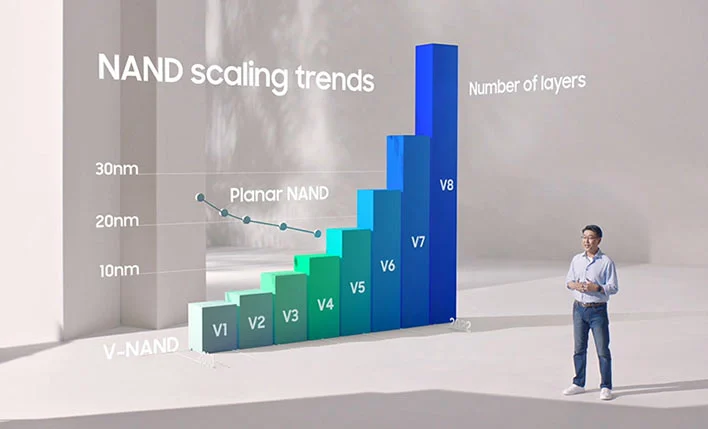During the China Flash Memory Market Summit (CFMS2023), Samsung Electronics, along with other flash memory companies including Micron, Kioxa, Arm, Solidigm, and Phison, discussed the “Re-evolution of Flash Memory and Towards a New Era.” Samsung Electronics specifically mentioned its plans to offer SSDs with capacities of up to petabytes using future 3D NAND technology, although this may take a decade or more to achieve due to the challenges associated with developing such high-capacity memory.
According to Kyungryun Kim, the VP/GM of NAND Product Planning Group at Samsung Electronics, there are three evolving levels of technology: physical scaling, logical scaling, and package technology, which are theoretically capable of achieving capacities of up to one petabyte (PB) or 1,024 terabytes (TB). However, the company does not expect to reach this goal using current technological standards for at least ten years. Samsung is also exploring the use of quad-level cell technology for more memory devices and working to improve its capabilities.
During the discussion about achieving higher capacities, Samsung also showcased their latest solid-state drive, the PM1743 series, which utilizes PCIe 5.0. The company claimed that this new series is 40% more energy-efficient than previous models and has been tested to work seamlessly with Intel and AMD PCIe Gen 5 platforms.
Samsung has been known to keep its technological progress regarding 3D NAND memory under wraps. However, the company is now aiming to introduce quad-level cell 3D NAND devices to the market with higher adoption rates. Samsung believes that improving controller technology would help achieve this goal. At present, Samsung focuses on physical scaling of 3D NAND devices. However, to achieve memory device access beyond one thousand layers, the company would need to explore logical scaling, which would allow for an increase in the number of bits of information stored within each cell.

While Samsung has been relatively quiet about its technology advancements, its competitor Kioxia has been more forthcoming. Kioxia introduced penta-level cell 3D NAND memory in 2019, which could store up to five bits per cell. Two years later, Kioxia surpassed the 5 bpc technology and reached 6 bpc. The company also indicated that it was researching whether it could go as high as 8 bpc, which would create an octa-level cell 3D NAND memory device, though it has not achieved this yet.
Manufacturers of 3D NAND face several challenges when it comes to storing multiple bits per cell. One significant obstacle is identifying materials that can store different voltage states without interference. They must also create error-correction techniques to ensure that data remains intact as the number of bits per cell increases.
Via AS Mag



